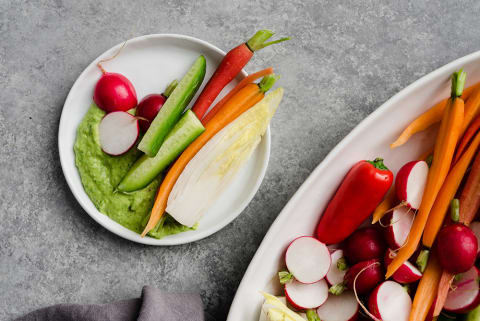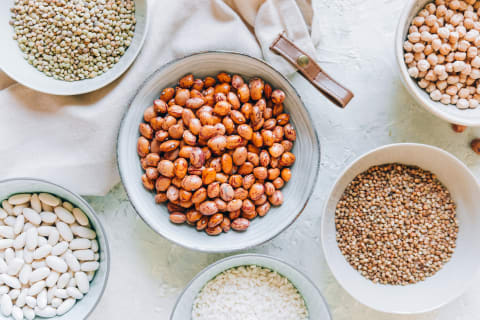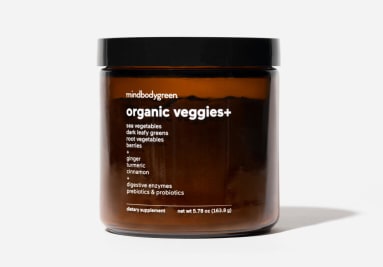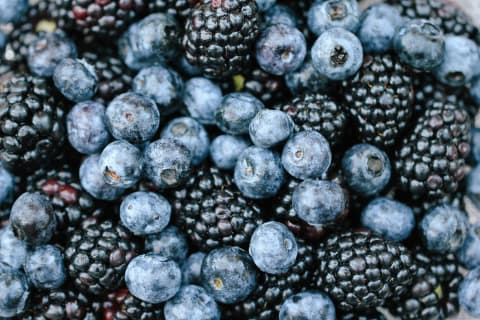How To Eat Sustainably: Food Lists & Pro Tips To Get You Started

Of all the ways to live more sustainably, tweaking your diet has got to be one of the most impactful. We load up our plates three times a day, after all—and each one is an opportunity to support the food system we'd like to see. But where to begin?
We dove into the latest research and consulted food and nutrition experts to put together a sustainable eating guide that outlines some of the best—and worst—foods for the planet and how to consume them.
What does it really mean to eat sustainably?
"At a very broad level, a sustainable food system protects the planet and its people," Sujatha Bergen, health campaigns director at the Natural Resources Defense Council, tells mbg. More specifically, foods that don't require much water to grow, contribute to land clearing or biodiversity loss, or emit large amounts of greenhouse gases (carbon and methane are two of the biggies in agriculture) tend to be considered more sustainable for the planet.
Of course, truly sustainable diets need to take human livelihoods into account too. "Sustainability encompasses not only the environmental but also the social and economic equity aspects of the food system," Kristin Reynolds, Ph.D., chair of food studies at The New School and lecturer at Yale School of the Environment, explains.
As discussed in Julian Agyeman, Ph.D.'s framework on "just sustainabilities," areas of environmental injustice also tend to be areas of social injustice and vice versa. It's no wonder that the United Nations' second Sustainable Development Goal seeks to "end hunger, achieve food security and improved nutrition, and promote sustainable agriculture." In order to create a food system that can sustainably feed the world into the future, all these needs must be addressed simultaneously.
Why it's important
The food industry is massive, so reducing its impact will go a long way in helping us avoid the worst impacts of climate change.
"More than a third of the land that we use globally is used for agriculture, and about a billion people work in the agriculture sector," says Bergen. And while one person changing their diet won't save our planet, director of nutrition at Tulane University Diego Rose, Ph.D., MPH, explains that if everyone did something, the savings would be huge.
In a study published earlier this year1, Rose and a team of researchers measured the carbon and water footprint of 16,800 Americans' daily diets. They found that if the group with the most environmentally taxing diets made just one sustainable food swap a day, it would reduce their diet's overall daily footprint by up to 48.4%. As Bergen notes, and this research demonstrates, "Even small diet changes can make a big difference."
What to know about meat
It won't come as much of a surprise that the industrial livestock sector has a major environmental impact. But it's worth sharing the numbers, just because they're so staggering: Global livestock production is responsible for 14.5% of human-induced greenhouse gas emissions, according to the FAO, and while it occupies nearly 80% of agricultural land, it provides less than 20% of the world's calories.
To understand the climate impact of meat, first consider the amount of land that's required to grow food to then feed to animals. "In many places, there is competition between land use for agriculture and land use for preserving biodiversity and some of our most important forests," Bergen notes, pointing to regions like the Amazon that show how large-scale animal agriculture can destroy local communities and ecosystems.
Then, you have the emissions of the livestock itself. Ruminant animals (cows, sheep, and goats) are the worst offenders here. They have multiple stomach compartments that break down food through a fermentation process that releases methane—a powerful greenhouse gas that has 25 to 80 times the warming potential of carbon dioxide.
"That methane gas is what's really contributing to their impact," Rose notes. According to one 2017 analysis, the overall environmental impact of ruminant meat is about 100 times that of plant-based foods. Not to mention, plant-forward diets tend to be healthier than carnivorous ones by most metrics.
Livestock with a so-called monogastric (aka, one-chamber) stomach design (think chickens and pigs) do not emit methane and therefore tend to be a better pick from a sustainability perspective.
But of course, the way an animal is raised also affects its overall impact. Grass-fed meat from a small farm that uses regenerative grazing practices will be a better choice for the environment, animal welfare, and human health than meat raised on a feedlot somewhere.
Like every other sustainability conversation, this one is nuanced, and it doesn't have easy answers.
A spotlight on regenerative agriculture:
9 foods that tend to be more sustainable
Now it's time to explore where all of this leaves you: the hungry consumer with a grocery list.
First and foremost, given the complexities of the food system, it's important to note that no one food is inherently "good" or "bad" from a sustainability perspective. Again, it's all about where it comes from, how it was grown, who grew it, etc. A person's cultural background and nutritional needs will also affect their ideal diet, and not everyone has access to eco-options, so it's important not to shame or blame.
With that being said, the following foods tend to have the lowest environmental footprint in terms of water use, land use, and greenhouse gas emissions. If you're looking to eat more sustainably (and oftentimes, more healthily), this list is a good place to start:
Organic fruits & vegetables

As mentioned earlier, plants tend to be a lot less resource-intensive to grow than animals. And Bergen adds that organic fruits and veggies are even better from an environmental perspective since they aren't grown using chemical pesticides and fertilizers.
Not only do these come with health concerns, but they can also be bad for soil health, made from planet-warming fossil fuels, damaging to nearby wildlife, and threatening to farmworkers. To keep the cost down, she recommends buying organic items listed on the EWG's Dirty Dozen list of the most-sprayed produce. Strawberries, spinach, kale, collard, and mustard greens currently top the list.
As far as specific produce items that require the fewest resources to grow, onion, celery, potatoes, and carrots topped one 2015 study on the foods with the lowest global warming potential by weight. Foods grown outdoors tend to be less resource-intensive than those grown in climate-controlled greenhouses.
Regenerative fruits & vegetables
Regenerative agriculture takes organic concepts one step further by limiting pesticide use and using farming practices that prioritize soil health. By utilizing techniques like crop rotation, composting, and hand tilling, regenerative farms seek to support soils' natural capacity to pull carbon out of the atmosphere.
Studies have even shown that produce grown on regenerative farms boasts more nutrients than traditionally grown fruits and veggies. Here's a primer on how to find them.
Local and seasonal fruits & vegetables
Eating locally and seasonally will ensure that your produce didn't take a long-haul flight to get to you, making it a straightforward way to cut down on emissions. (Transportation accounts for about 15% of a food's2 total greenhouse gas load.) Plus, it's usually a tastier and fresher way to eat. Joining a local food program like a CSA can help you learn what's available in your area. You can try your hand at growing some of your own food too (even if you live in an apartment).
Legumes (lentils, chickpeas, beans)

Bergen notes that legumes also tend to be on the lower end of the spectrum of greenhouse gas emissions. Crops like lentils, chickpeas, and beans can also help invigorate farmland with healthy nitrogen3, making them a soil-friendly diet addition.
Grains
Grains also tend to have relatively low greenhouse gas emissions4, with options like rye, barley, and oats requiring less carbon to grow by weight than rice, which has a slightly higher footprint. However, since grains are such a cheap diet staple around the world, they are often grown in monocultures—farm plots that deplete soil health by growing huge amounts of only one crop. Look to buy from smaller, more dynamic farms when you can.
Mackerel, clams, mussels, sardines, and anchovies
We could easily spend a whole article diving into the eco pros and cons of seafood (and we have!), but in short, small seafood tends to be best for human and environmental health.
For starters, it is less likely to be overfished in the wild, and it takes fewer resources to farm. Fish that are lower on the food chain will also naturally replenish faster than their predators. They don't accumulate as much mercury over their short lifespan, either.
However, the seafood industry is rife with human rights abuses (read a marine scientist's take on the issue here), so it's important to know where your seafood is coming from, no matter what you're buying.
Seaweed
Seaweed is a crop that requires next to nothing to get started and is quick to grow. Plus, the marine plant can help capture carbon and filter out water pollutants as it spreads. It may even prove useful in reducing the methane emissions of those gassy ruminants. A growing wave of seafood farms are now popping up along the coast of the U.S., and you can find the gut-healthy plant in everything from pasta to burgers. Check out a list of food companies selling it here.
Fungi & mushrooms

Like seaweed, mushrooms are a low-input crop that can grow in inhospitable areas without much fuss. (They're even surprisingly easy to grow at home.) Some varieties also have a meaty texture and taste, making them a nice vegetarian substitute.
Nuts
As a category, nuts fall somewhere in the middle of the sustainability spectrum. While some varieties like peanuts (technically a nitrogen-fixing legume) have a pretty low footprint, Rose notes that other options like almonds are very water-intensive and tend to be grown in already water-starved areas like California.
10 less sustainable options (and a swap for each)
The following items tend to have a higher environmental impact. If you're looking to eat more sustainably, try to consume them in moderation. Remember, even one swap a day can make a big difference in your overall food-print.
Beef

"In the U.S. diet, beef is the single biggest contributor to global warming emissions," Bergen notes—by a long shot. Rose explains that in his review of the foods that Americans eat that have the highest environmental impact, the top 10 were all beef products.
If you're going to make one change to your diet, swapping a cut of beef for another protein (even another animal, like chicken or pork) is likely the one that will have the largest impact.
Swap for: Plant-based protein, chicken, pork, or regeneratively raised beef
Lamb
While lamb isn't as popular as beef (in the U.S., at least), sheep require even more land to grow and feed than cows do on average, and they also emit methane into the atmosphere.
Swap for: Plant-based protein, chicken, pork, or regeneratively raised lamb
Goat
The final ruminant animal on the list, goats and their byproducts are associated with significant greenhouse gas emissions too.
Swap for: Plant-based protein, chicken, pork, or regeneratively raised goat
Dairy milk

Dairy is also climate-intensive since it comes from cattle. There are plenty of alt milks to choose from these days, and while they all require different amounts of land and water to grow, Bergen says they are almost always more sustainable than dairy milk.
Swap for: Nondairy milk or milk from a regenerative dairy farm
Cheese, butter, and yogurt
Also byproducts of cows and ruminant animals, cheese, butter, and yogurt are not the most sustainable options. (Trust me; it pains me to write this as much as it pains you to read it!)
Swap for: Cashew "cheese," tahini, plant-based yogurts
"Red list" seafood
The "Red List" of the Monterey Bay Aquarium's Seafood Watch flags fish associated with environmental or human rights concerns. Though it depends on where it was caught/raised, some types of fish that often make the list include shrimp, tuna, and Chilean sea bass (toothfish).
Swap for: The smaller fish listed above (salmon, mackerel, anchovies, sardines, herring)
Bottled water and soft drinks
While not nearly as resource-intensive as red meat, Rose notes that many beverages have a higher footprint than you might expect. This is in part because they come with lots of packaging and tend to be pretty heavy to ship.
It also takes a lot of raw material to make our favorite drinks. "Say you make a glass of orange juice. It takes a lot of oranges to do that. And then most of what's left over gets thrown away. Same with wine or beer," he explains. "There's a lot of processing that's going on to get to that output."
Swap for: Filtered water from the tap
Delicate out-of-season fruit
While blueberries and raspberries do make for a sweet treat in winter, Rose notes that they will not be the most sustainable option. More often than not, these fragile fruits were shipped to you from somewhere else on an airplane—and have the carbon emissions to prove it. "They're particularly bad if they were grown in a greenhouse because then you have the impacts from that and the air travel," he explains. "That's a big price on the environment too."
Swap for: Seasonal fruits or preserved jams
Palm oil
Palm oil plantations are a major driver of deforestation around the world, particularly in Southeast Asia. The cheap oil can be hard to avoid (beyond just food, it's in tons of personal care products), so look for RSPO-certified deforestation-free palm when you can.
Swap for: RSPO-certified palm oil
Table sugar
Like palm oil, table sugar (sucrose) is a cheap crop that's now being grown in areas of high biodiversity. (It's also pretty water-intensive to cultivate5.) Swap it for other natural sweeteners that don't have the same land-use concerns.
Swap for: Honey or maple syrup
Tips to follow a sustainable diet
Beyond making these sustainable swaps, here are a few more ways experts recommend reducing the overall impact of your diet:
Use meat as a flavoring rather than the main dish.
"The American idea is that you have the main protein item as the center of your plate, but in a lot of cultures, the meats or the fish is used in a sauce," Rose notes. Take a cue from this eating philosophy and think of meat as less of a centerpiece and more of a side dish for those veggies, grains, and plant proteins.
Reduce your food waste.
"Another part of eating sustainably is to reduce the amount of food you're wasting," says Bergen, because that's just energy and resources you're throwing in the trash. According to one 2014 analysis, food loss makes up a whopping 28% of the overall carbon footprint of the average U.S. diet each year; equivalent to the emissions of 33 million cars.
"We all throw out too much food," Rose says, but you can keep waste to a minimum by planning your meals ahead of time, only buying what you need, and getting creative with your scraps using recipes like these:
Start composting.
Compost any food scraps you do have so that they funnel back into the earth instead of decaying in a landfill (another source of planet-warming methane). Join a composting program in your community or start a bin at home using this guide.
And here's yet another reason to avoid cooking with meat: Animal scraps don't belong in your bin!
Avoid packaging.
Reynolds says that avoiding food that comes in plastic packaging is another way to reduce the environmental impact of your diet, though she notes that isn't feasible for everyone. But if you do have the time and resources to shop for loose produce, get your grains from the bulk bin, or make your own package-free nut milk, by all means.
"A caution, however, is that making these types of changes is not a stand-in for systems-level and policy changes that can support more sustainable and equitable food systems," Reynolds adds, bringing us to the final point.
Advocate for system-level change in your area.
Reynolds and Bergen agree that the Good Food Purchasing Plan (recently passed by New York City and Chicago!) is one policy that stands a real chance of changing the way we consume food in this country. Encourage your local government or school board to sign on to stocking their menus with healthy and sustainably grown food.
"Readers can take steps to learn about similar policies, or efforts to create them, where they live and support policymakers who are making well-informed and community-driven food policy a priority," Reynolds adds.
Frequently Asked Questions
What is the most sustainable way to eat?
Eating plenty of fruits and vegetables (preferably local and in-season), grains, legumes, responsible sourced fish, and nuts tends to be a good way to go for the planet. It's no wonder that the Mediterranean diet is typically considered the most sustainable eating pattern.
What are the 5 tips for sustainable eating?
Get started by using meat as a flavoring rather than a main dish, reducing your waste, composting what's left, reducing the amount of food you buy in packaging, and advocating for changes in your local food system.
The takeaway
Food systems are super complex, but consider this guide an appetizer in your journey to find a sustainable diet that works for you, and advocate for a food system that supports your community and the world at large.

Emma Loewe is the Sustainability and Health Director at mindbodygreen and the author of Return to Nature: The New Science of How Natural Landscapes Restore Us. She is also the co-author of The Spirit Almanac: A Modern Guide To Ancient Self Care, which she wrote alongside Lindsay Kellner.
Emma received her B.A. in Environmental Science & Policy with a specialty in environmental communications from Duke University. In addition to penning over 1,000 mbg articles on topics from the water crisis in California to the rise of urban beekeeping, her work has appeared on Grist, Bloomberg News, Bustle, and Forbes. She's spoken about the intersection of self-care and sustainability on podcasts and live events alongside environmental thought leaders like Marci Zaroff, Gay Browne, and Summer Rayne Oakes.
5 Sources
- https://academic.oup.com/ajcn/article/115/2/378/6459912?login=false
- https://pubs.acs.org/doi/10.1021/es702969f
- https://www.frontiersin.org/articles/10.3389/fpls.2018.00313/full
- https://www.sciencedirect.com/science/article/abs/pii/S0959652616303584
- https://www.sciencedirect.com/science/article/pii/S0570178320300439


